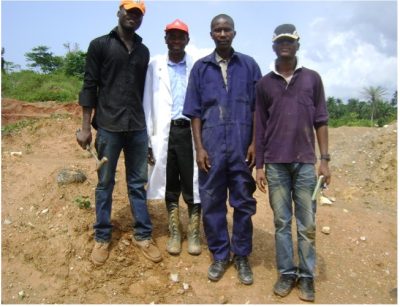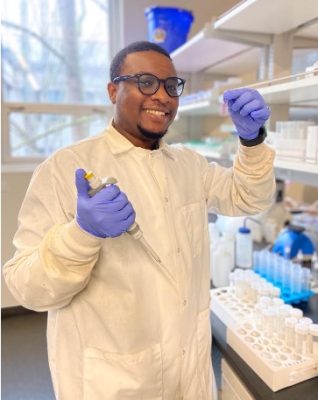The Accidental Geochemist
Growing up in a picturesque environment dotted with some of the oldest rocks in Nigeria was inspiring for me as a young boy and motivated my later professional decisions. During my senior year in college, I was introduced to the field of applied geochemistry by my professor when he suggested the prevalence of cancer in a community may be linked to rare earth metal mining. Before I knew it, I made environmental geoscience a career choice.

Fatai (far right), professor (white lab coat) during his undergraduate research field work in Nigeria.
Following my experiences studying cancer-causing metals from rare earth metal mining, I have examined factors influencing how harmful heavy metals such as lead, vanadium, and chromium are transformed in and move through the environment.
I am particularly fascinated by the ways chromium can transform into more harmful forms which can contaminate soil and drinking water sources. The carcinogenic form of chromium, called hexavalent chromium (Cr (VI), was brought to light by Erin Brockovich’s lawsuit against Pacific Gas and Electric (PG&E).
The good, the bad, and the ugly of Chromium
Chromium is a naturally occurring and essential mineral important in metabolizing glucose in humans. While some forms of chromium have neutral effects on human health, such as trivalent chromium or Cr (III), hexavalent chromium or Cr (VI) is known to cause cancer.
Hexavalent chromium is usually introduced into the environment by industrial processes such as leather tanning, stainless steel production, and wood preservation. However, “hotspots” of naturally occurring Cr (III) in rocks below the surface can be a problem, as there are sometimes geologic materials present which can initiate chemical reactions that transform Cr (III) to Cr (VI).
The most prevalent of these are minerals known as manganese oxides. When this transformation occurs, Cr (VI) may be transported and dissolved in groundwater, where it could cause several types of cancers as well as kidney and liver failure in people who are exposed, for example through drinking water from a private well.
Making lemonade from lemons

Fatai Balogun
My research aims at understanding how certain soil components can produce or reduce hexavalent chromium in the natural environment. I am using laboratory experiments to study how a crucial soil component called citric acid, which is in some food we eat, like lemons, combines with manganese oxides (which are also abundant in soils) to produce Cr (VI).
One important finding from my work is that increasing the amount of citric acid in these experiments reduced the amount of Cr (VI) significantly. The result could help other scientists in making more accurate models that could help predict risks of contamination in areas underlain by chromium-laden aquifer material. Further research can help us understand how the use of citric acid may aid as an in-situ remediation technique where groundwater has been contaminated by hexavalent chromium, thereby safeguarding the health of communities who rely on well water for drinking.
